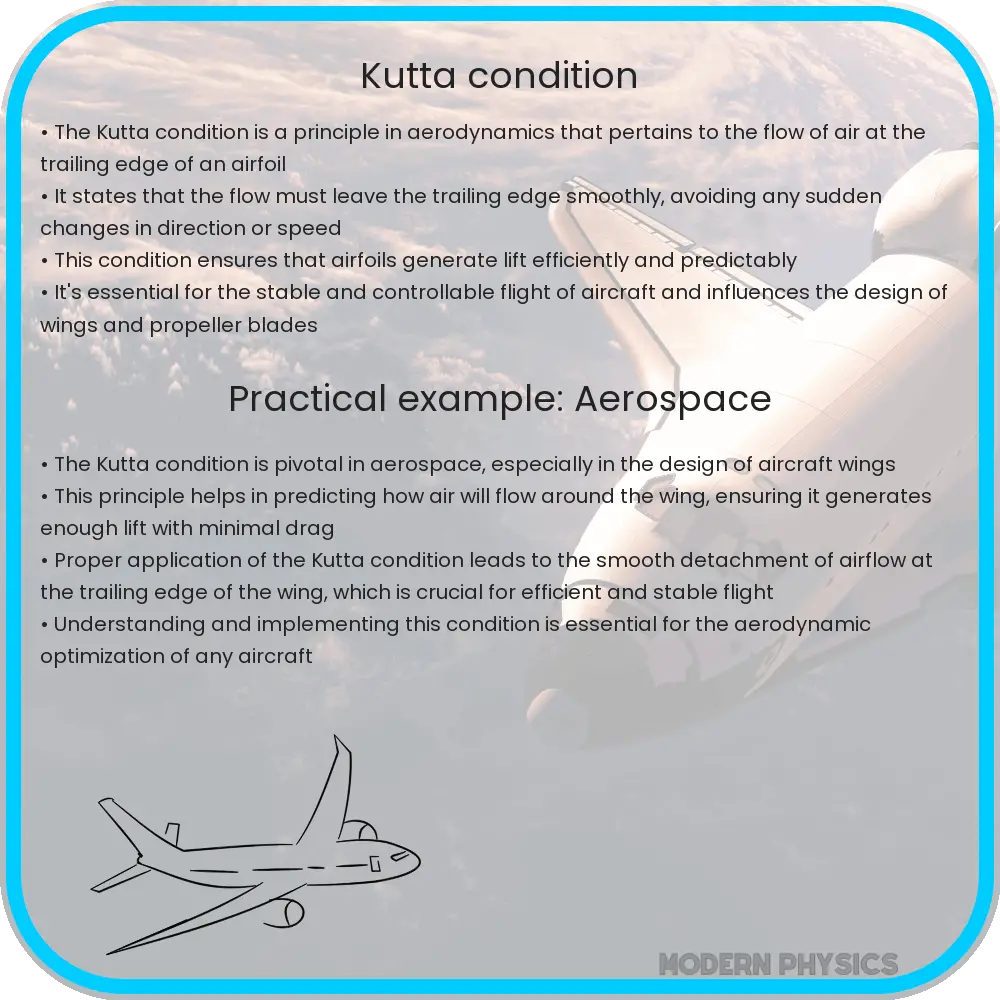Explore the Kutta Condition in aerodynamics: its crucial role in airfoil design, lift generation, stability, and modern aerospace innovations.

Kutta Condition: A Cornerstone in Aerodynamics
The Kutta condition is an essential concept in aerodynamics, playing a critical role in understanding the stability, lift, and airfoil design of aircraft. This principle, named after the German mathematician and engineer Martin Wilhelm Kutta, is a boundary condition that explains how air flows over the sharp trailing edge of an airfoil. It’s a fundamental aspect in the design and analysis of wings and other aerodynamic surfaces.
Understanding Airfoil and Lift
An airfoil is a shape designed to generate lift when air flows around it. The most common example is the cross-sectional shape of an airplane wing. Lift is the upward force that allows an aircraft to rise and remain airborne. It occurs due to differences in air pressure on the upper and lower surfaces of the wing, a phenomenon described by Bernoulli’s principle.
How the Kutta Condition Influences Lift
The Kutta condition states that the flow of air around the wing will leave the trailing edge smoothly, without any sudden changes in direction or velocity. This smooth flow ensures efficient lift generation and minimizes turbulence, which could otherwise decrease lift and increase drag. The condition is automatically satisfied in real-world scenarios, as the air naturally adjusts to flow smoothly off the trailing edge.
Implications for Airfoil Design
Airfoil design is a complex process involving the shape and size of the wing, its curvature (camber), and the angle at which it meets the oncoming air (angle of attack). The Kutta condition influences these design choices, ensuring that airfoils are shaped to maximize lift while minimizing drag. For instance, sharper trailing edges on an airfoil can better fulfill the Kutta condition, leading to more efficient lift production.
Designers also use the Kutta condition to predict the circulation around an airfoil, a key factor in determining lift. This prediction helps in optimizing airfoil shapes for various flight conditions and aircraft types, from lightweight gliders to supersonic jets.
In summary, the Kutta condition is a crucial aspect of aerodynamics, deeply influencing the design and performance of airfoils. Its application ensures efficient lift generation, which is fundamental for the stability and operability of aircraft.
Role of the Kutta Condition in Stability and Performance
The Kutta condition’s influence extends beyond lift generation to the overall stability and performance of an aircraft. Stability in flight is crucial for safety and maneuverability. By dictating the airflow pattern around the airfoil, the Kutta condition helps in maintaining a stable and predictable lift force. This stability is particularly vital during critical phases of flight like takeoff and landing, where the angle of attack and airspeed vary significantly.
Advanced Applications in Airfoil Design
Modern airfoil design leverages computational fluid dynamics (CFD) and wind tunnel testing to optimize the application of the Kutta condition. These tools allow engineers to simulate and analyze how slight changes in airfoil geometry can impact lift, drag, and overall aerodynamic performance. This level of precision is essential in designing high-performance aircraft, where even small improvements can have significant impacts on efficiency, speed, and fuel consumption.
Challenges and Innovations
While the Kutta condition provides a foundational understanding of lift generation, it also presents challenges. For instance, at high angles of attack or in turbulent conditions, the smooth flow required by the Kutta condition can break down, leading to a loss of lift known as stall. Addressing this, engineers have developed airfoil designs and mechanisms like slats and flaps to maintain lift in various flying conditions.
Environmental Considerations
Environmental concerns have also influenced airfoil design in recent years. Engineers are increasingly focusing on designing wings that not only fulfill the Kutta condition but also reduce noise and emissions. This involves optimizing the airfoil shape to reduce drag and, consequently, fuel consumption, contributing to more environmentally friendly aviation.
Conclusion
The Kutta condition is more than a mere aerodynamic principle; it’s a cornerstone in the field of aerospace engineering. Its application in airfoil design is fundamental to generating efficient lift, ensuring flight stability, and enhancing overall aircraft performance. As aviation technology advances, the principles of the Kutta condition continue to guide innovations, addressing modern challenges like environmental impact and flight safety. In essence, the Kutta condition remains a pivotal factor in shaping the future of aircraft design and aerodynamic understanding.
